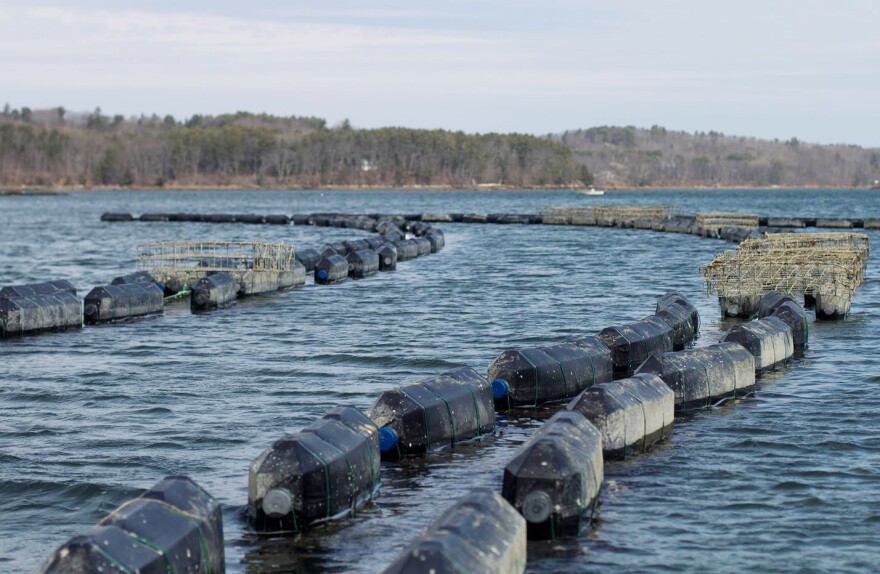There are an estimated 30,000 Mainers who, one way or another, depend on the state's marine economies, and it seems every one of them is contending with some sort of hit right now, as the COVID-19 pandemic has upset the long-established systems of seasonal seafood supply and demand.
Jeff Augur says that when famed Boston restaurant chain Legal Sea Foods started closing doors two weeks ago, the trend was obvious. But still “it was amazing how quickly it came crashing to halt."
Augur is river foreman at one of the big Damariscotta River oyster-growing operations, Mook Sea Farm. He says that about a week ago, trucks sent to the company's usual Boston buyers started coming back almost fully-loaded with unsold oysters. Then it got worse.
"This week we all worked half the hours and then, unfortunately, we've had to furlough about 70-80 percent of the crew."
That's about a dozen workers, he says. Most or all of the region's oyster farms find themselves on the ropes during what is usually one of the busiest times, after a winter slowdown.
And this was supposed to be serious money-making time for the state's elver fishermen.
"The elver price is $500 a pound compared to the $2000 we got last year," says Krista Tripp of South Thomaston.
Tripp is, like many in Maine's seafood industry, a multi-faceted saltwater entrepreneur. In addition to netting the glass eels to serve now-anemic Asian markets, she's a sometime sternman on her father's lobster boat, and she runs a small oyster farm as well.
Tripp says that the COVID-19 pandemic has laid waste to the U.S. restaurant sector, which usually accounts for about 70 percent of seafood sales in the U.S. and Maine.
"We're usually selling to the restaurants and different distributors, I sell to different distributors, and all of those markets have stopped."
Up the coast in Stonington, lobsterman Genevieve McDonald says this time of year she's usually getting her boat back in the water and ready to hunt for a specialty fish, halibut. But she's holding back for now.
"I'm not sure there will be a market. We sell to a niche market that gos directly to restaurants. I have a feeling these fine-dining establishments probably are not serving fresh halibut right now."
She's staying busy enough, though. McDonald represents Stonington and other fishery-dependent Downeast towns in the state Legislature. She's been on the phone a lot with Maine's congressional delegation, seeking details on just how Maine fishermen and aquaculturists can access unemployment benefits or small business loans to help tide them over these rough waters.
Maine's lending community, she adds, is stepping up.
"I have a boat payment myself, and I was able to work with my lender, and I've talked to other fishermen who've been able to get extensions as well."
And it's not like Maine fishermen are throwing up their hands and waiting for a government bailout. Many are selling their hauls at pop-up markets where they often can get a better price than from dealers, if dealers are buying at all.
That can continue now, even with Gov. Janet Mills' latest stay-at-home order. According to the Department of Marine Resources, lobstermen are considered "essential" workers, and their licenses entitle them to sell directly to consumers, although guidance for shellfish is a little more complicated.
"The local food movement right now is on fire in Maine."
And buying closer to the boat is a great thing, says Annie Tselikis, executive director of the Maine Lobster Dealers Association.
Wholesalers struggling to keep up their usual level of purchases want to see local boats, bait shops and wharfside businesses stay healthy in whatever way possible. But, she adds, the entire value-chain needs support, including from the $300 million U.S. Sen. Susan Collins helped earmark for the seafood industry within the latest federal stimulus package.
"We're also concerned for our customers in places like Chicago or Houston, because if they are not liquid, if they are not able to purchase product and distribute to their bars and casinos, then our product doesn't have the value that it needs to have here. So we are looking at this holistically as the entire seafood industry in the United States."
It could be weeks before federal dollars actually start flowing to the states and thence to their strapped businesses. Oyster farm foreman Jeff Augur, whose company is continuing health benefits for furloughed workers, says the potential $600 a week unemployment benefits can't come soon enough for his crew.
"The practical question is, is it going to be there this week, next week or the week after, or in a month and a half?"
But for the state's dominant seafood fishery, lobster, the timing could be worse. Many of the smaller inshore operations usually don't get going until late spring. And for some of the big offshore trawlers, there's the federal scallop season near Gloucester, Mass. that opened just this month.
Chebeague Island fisherman Alec Todd and his son, who headed down there this week, says it was a very different scene from previous years.
"We spent the whole time on the boat there alone. I mean, it's totally different from other years when we were down there we'd go to eat breakfast, we'd go to eat lunch, go do whatever. We're just stuck on the boat, quarantined I guess."
He says the price scallops fetched at the New Bedford auction weren't eye-popping, but still strong enough to make the trip worth it. That, he says, and new demand from locals in Maine who ask that he save some of those shellfish back, to sell to them when he gets home.
Originally posted 5:56 p.m. April 3, 2020



